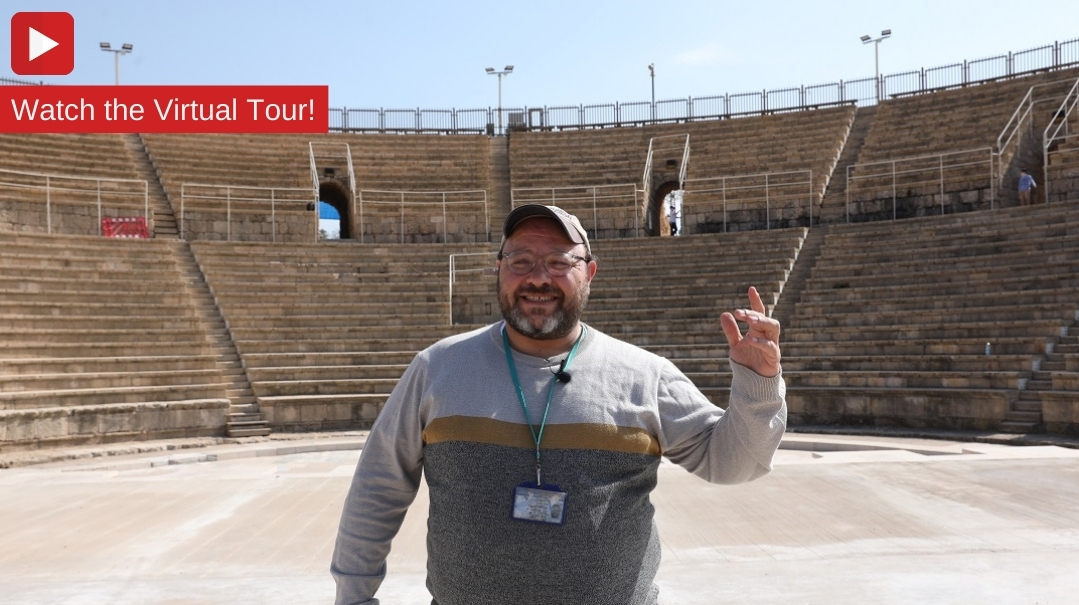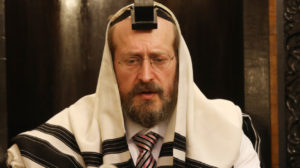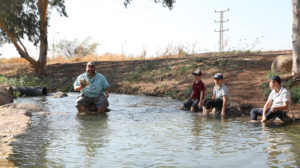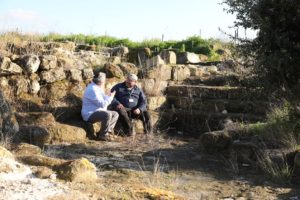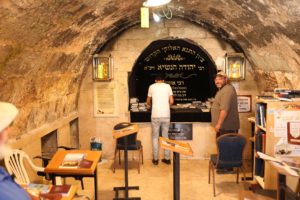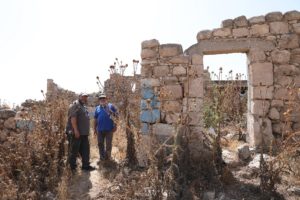Roman Holiday
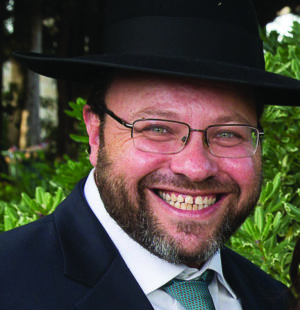
Climbing on the ancient ruins of Caesarea
One or the Other
In more conventional days, when the skies were open and tourists flocked to Eretz Yisrael, the first and foremost stop was, of course, Jerusalem. But the skies are closed, and most of the museums and sites in the holy city aren’t even open for visitors. Baruch Hashem, we can still go to the Kosel, which has been divided into “capsules,” but Tziyon is crying for her absent children. So where shall we virtually tour this month?
Well, to paraphrase Chazal’s instruction regarding Jerusalem and Caesarea, that “If someone tells you that both are destroyed, do not believe him; if he says that both are flourishing, do not believe him… if this one is inhabited, that one is destroyed, and if that one is inhabited, this one is destroyed” (Megillah 6a), if Jerusalem is shut down then let’s check out Caesarea. There are lessons of galus that we’re meant to learn there until Jerusalem and the Beis Hamikdash will be rebuilt once again. And sure enough, even the Ministry of Health — or whoever is making up the rules of the week these days — has ordered that national parks should be open. So it’s off to Caesarea as we go to explore Jerusalem’s ancient foil, the Roman city of many gods, Roman-style entertainment, and painful memories.
Driving into Caesarea we pass through the town of Ohr Akiva, about a mile away from the ancient Roman city. There aren’t too many cities or even yishuvim in Israel named after Tannaim (your homework is to name at least three others). But the name is perhaps most appropriate, for Rabi Akiva, who was tortured and murdered in Caesarea, symbolizes hope for the future even as there is destruction all around — upon witnessing the foxes running out of the ruins of the destroyed Beis Hamikdash, he was able to laugh, for he saw in that the ultimate rebuilding and redemption. It is those thoughts, and that hope, of Rabi Akiva that we carry with us into the excavated ruins of Caesarea in an Eretz Yisrael that still awaits the Geulah, but that certainly is no longer in ruins.
Our first stop at the entrance to the Caesarea National Park is a model of the city. This was a central metropolis for over 1,200 years, originally built about 80 years before the Churban by Herod (who humbly called himself “the Great”). Herod’s intention was to build Caesarea as a Roman city from the very beginning, and he named it after Augustus Caesar, who was his benefactor.
While in Jerusalem, Herod needed to respect traditional Jewish sensibilities; but when he built Caesarea on the ruins of a small fishing village, he pulled out all the stops to create a major metropolis in true Roman fashion, building the world’s largest artificial harbor, temples to the Roman gods, a large Roman theater, horse-racing facilities and other sports events that were unmatched at the time. At its peak, Caesarea was the largest city in the country, with a population of approximately 125,000 people.
The city was made into the capital of the Judea province by the Romans after Jerusalem was conquered, and games were held there to celebrate the victory of Titus. Many Jewish captives were brought there, only to be slaughtered by gladiators to the roar of the cheering crowds.
The city was later taken over by the Christian Byzantines, conquered by the Muslims in the 7th century, and rebuilt again by the Crusaders in the 11th century, until it was ultimately destroyed in the 13th century by the Mamluks — slave warriors controlled by Muslim rulers — in line with their general practice of destruction to prevent its reemergence as a Crusader stronghold.
Live from Caesarea
We make our way over to the large theater that overlooks the Mediterranean — which became famous in the frum world after the “Yaakov Shwekey Live in Caesarea” concert that took place here ten years ago. (You have no idea how many people only know of the city from that concert.) Yet in Roman times, the theater here was far from kosher, despite the fact that Roman theater (think Mishpacha magazine) didn’t feature any women’s faces. All the entertainers were men, although some dressed up as women for those roles in tragedies or comedies. Chazal referred to the productions as a moshav leitzim, while Rabi Meir went a step further, decrying them for the idolatrous and pagan rituals that would be performed. The backdrop of the theater, which once sat over 6,000 people (today it’s reconstructed to seat about 3,700), wasn’t the Mediterranean then, but a large wall behind the stage called a scaena (like the word scene), that were filled with idols and sculptures.
The Gemara tells us about of one of the employees of this theater. It seems there was a famine in Eretz Yisrael and the Amora and chief rabbi of the city, Rabi Abahu, had a dream that the rains would only come if someone named Pentacaca would daven for them. (The name refers to the five sins he would commit daily in his work providing all sorts of entertainment for the city’s visitors.) When Rabi Abahu asked him if there were any merits that he may have had, Pentacaca told him of the time he had met a woman whose husband was sentenced to death, and how she was about to sell herself in order to set him free. Pentacaca would have none of that, and sold his own bed and sheets to redeem him. Rabi Abahu told him that he was certainly fit to pray on behalf of the Jewish People for rain — a bit of Yaakov’s light shining through the darkness of Eisav.
Built to the Hilt
We walk from the theater through the later Muslim gates that cut off the theater from the city, toward a large pillared structure that juts out to the sea. A few years ago, they had these virtual reality glasses you could put on that would recreate the scene from back then, and we were able to see the huge gardens that grew here surrounded by the bustling buildings of an administrative center — the Israeli White House of the Roman Empire. Behind all of that was a vision of Herod’s palace, replete with its mosaic floors that line what seems to be an Olympic-size swimming pool built into the sea. This was a fresh water pool that drew water from the aquifers on the shoreline. Herod apparently liked to relax in a pool by the sea, but wasn’t a fan of the saltwater. In an ironic twist, on the side of the pool, archaeologists uncovered a post-Herod mikveh built by the local Jews, who probably relished the comparison.
Who was Herod the Great, and what was so “great” about him? Well, he was definitely good for tourism, both then and now. He was a master builder who built the expansion of the Second Beis Hamikdash, the fortress at Masada, the Mearas Hamachpeilah complex, and other major projects. He certainly left his mark on this country. But what’s his backstory?
Now, as Chanukah approaches, it’s a good time to brush up on the depressing post-Chanukah story of the Jews in Eretz Yisrael. It seems that despite the great neis and rededication by the Maccabees of the Beis Hamikdash, their victory was short lived; the great-grandchildren of the Chashmonaim were Hellenists once again. One of the last Chashmonai kings, Yochanan Hyrkanus, enlarged the borders of Eretz Yisrael by waging wars on all fronts, employing some good goyim as “real” soldiers. He conquered the Idumeans, a nation in the south that had descended from Edom, and issued them an ultimatum: either convert or be killed. Their leader, Antipater, who was well connected with Rome, agreed to convert and marshal his men to serve in the army on one condition: If they were joining, they weren’t going to be second-class citizens. His son Herod would marry Yochanan’s daughter Miriam.
Herod lived with this duality paranoia all his life. How would the Jews view him? How would the Romans view him? He decided he was going to outdo both of them, and so he built and built. Yet the paranoia remained, and he was known to murder anyone that he suspected of treason. His two sons were drowned right here in this pool by his own orders. And, Chazal tell us, it was here that his wife jumped out of the window and died rather than stay married to him. The Gemara tells us that he was so despondent that he had her congealed in honey and for seven years would bring her to all the state functions. (He would walk into the house and say “Honey, I’m home….”)
Ultimately when Herod died after a long and painful illness, he was buried at Herodion, the fortress and tomb he had built for himself south of Jerusalem. It is there that surviving Jews fled to during the Churban several decades later, and it is there that the first kinnos over the Second Beis Hamikdash were recited that year as they watched it burn down. Herod is the story of the building and destruction, encapsulated more than anywhere here in the city he built in honor of Caesar.
Fight for Your Life
Adjacent to Herod’s palace, we’re now standing in the huge amphitheater of ancient Caesarea (what Chazal call the “circus”). In Herod’s times it was used primarily for the Roman equivalent of NASCAR: chariot racing. In the later Byzantine period, the structure was expanded and used for horse races and called a hippodrome. But it was during that interim brutal Roman period that it was used for gladiator blood sports, and it was the site where many Jews — including some of the Asarah Harugei Malchus — were martyred.
Paintings of some of the ferocious animals that were brought here for these fights were uncovered by excavators over the years. There were elephants, tigers, rhinos, leopards, wolves, and huge wild dogs. The animals would be set upon one another, and then upon the prisoners and slaves — all to the bloodthirsty cheering of the Roman mob. The “highlight” would be the battle between the gladiators, enemy captured soldiers or prisoners trained as swordsmen and fighters, who would fight for their lives against one another. Some of these gladiators were in fact Jews. According to some opinions, the great Amora Reish Lakish trained as one before he did teshuvah, escaping his gladiator fate by killing his captors. It was truly the worst of times.
Whatever our rabbis have said about the prohibitions on theaters, fights like these certainly seem like places where nice Jewish boys shouldn’t be hanging out. And in fact, rabbanim at the time ruled that one who does attend is an accessory to murder. One Amora, though, declared that under some circumstances, it would actually be a mitzvah to attend. According to Rabi Nosson, the fate of the prisoner to be killed would be determined by the cheering of the crowds. The governor, who was seated in the center of the stadium, would raise his thumbs up for life and down for death, and based on the cheering, would direct the gladiator how to proceed. Thus, to come and cheer for someone to be saved would be hatzalas nefashos. An additional reason to attend would be to provide witnesses of the deaths of these Jewish prisoners, so that their spouses would be able to remarry and not remain agunos.
It was here that Rabi Akiva had his skin flayed by iron combs, where Rabi Chananya ben Tradyon was set ablaze wrapped in a sefer Torah as the letters flew up to Shamayim. And it is these very arenas, Chazal assure us, that will one day be filled with the sound of Torah.
Port in the Storm
As we leave the arena, we come to the shops, restaurants, and tourist traps of Caesarea. There’s a lot of excavations and construction going on here. About a year ago a new visitor center with a multimedia film exhibit and small archaeological museum was opened, but today it pretty much stands empty, as most of these indoor places are still closed.
We walk along the port and try to imagine what took it looked like back in those days. This was the primary port to Eretz Yisrael in the times of the Mishnah and Talmud. And although Caesarea was a large Roman city and later a Christian city, it always maintained an active Jewish population. The rabbanim of Caesarea were renowned throughout Eretz Yisrael, and in fact it was here that our order of blowing shofar was established by Rabi Abahu. Other Caesarean leaders were Rabi Hoshaya and Rabi Yannai, who were, to a large degree, the Jewish lobbyists to the Roman government — and many recordings of the discussions, debates, and arguments they had trying to balance the two worlds have endured.
There were better times and more challenging times. Josephus describes how the original revolt of the Jews that led to the destruction of the Beis Hamikdash began here when a fight broke out between Jews and the gentiles who desecrated the local shul by offering a heathen sacrifice. The Jewish riots were put down by the Roman forces, but those riots spread to Jerusalem and ultimately led to its destruction. It was one factor in guiding the rabbanim of Caesarea — and rabbanim in galus for the next two millennia — to build good relations with the local government and to avoid confrontation and incitement.
As we look out onto the breathtaking sea before us, we can understand why people would want to live here today. Yet, back then that view would be blocked by the many huge ships from all over the Roman empire that would dock here on their journey to do business in the Holy Land. Today the port is long gone, and all that’s visible are a bunch of scuba divers doing excavations. We can make out some breakwater about a half a mile out where the ancient stone walls once stood, but it seems that Herod, with all of his eternal architectural engineering feats, wasn’t able to create an enduring structure out at sea.
Although there isn’t a natural inland harbor where boats can dock without getting swept away by the sea, Herod hired a team of engineers to make it work. In what is truly an architectural feat, they dropped huge stones under water to create a foundation upon which they sank wood frames that could be moved to the exact positions on top of that foundation. They then filled the frames with concrete, upon which they built huge walls that would break the waves and enclose the area. This creative port lasted about a century, until it was destroyed by the many earthquakes Israel suffers as a result of the fault line on which it sits. With the destruction of the city by the invading rulers, the port became obsolete as Caesarea emptied out.
Saint of Infamy
As we exit, we pass by a closed restaurant, and perhaps for the first time in my hungry life I’m happy not to be going in. The name of the restaurant is “Hatzalbanim” — the Hebrew word for the Crusaders, which I would classify as being (no pun intended) in bad taste.
About 400 years after the Muslim conquest, the Crusaders arrived in Eretz Yisrael in the year 1099. It was not only on their journey from Europe that they massacred the various Jewish communities they passed through, but they didn’t stop once they reached the Holy Land that they were dead set on liberating. Although they were ultimately thrown out by the Muslims, they kept coming back again and again — sort of like a chronic case of strep throat. Caesarea was rebuilt by the last of the Crusader kings, Louis IX of France (Saint Louis), considered by many as the ideal Christian ruler and the only French king to attain sainthood by the Catholic Church. While in Europe he was heralded as a fair and devoted king, in Jewish history he will always live on in infamy. The 7th Crusade that he led to Israel in 1248 was funded from the property and money that was confiscated from Jews engaged in moneylending in France, whom he ceremoniously expelled and killed. He reinstituted the Inquisition in France and was the ruler who had 12,000 manuscripts of the Talmud burned in the streets of Paris.
Although his Crusade to a large degree failed (he was captured in Egypt and ransomed), he remained in Eretz Yisrael for four years and built up the Crusader cities, using Caesarea as his base of operations. After returning to Europe, he came back on the 8th Crusade to again attempt to conquer the Land, but died of disease along the way. I’m sure our ancestors celebrated the news. They certainly didn’t name any restaurants after him.
As we leave the city through the Crusader arched gates that Louis built, we cross over a moat to the parking lot and imagine the fierce battle in 1268 between the Mamluk army led by the fierce General Baibars and the Crusaders, which destroyed the city. The Mamluks had already destroyed most of the cities on the coastline — Haifa, Atlit, and Ashkelon had been razed and the Crusader forces slaughtered. Caesarea faired no differently; the city remained in ruins until the entire area was purchased from the Ottoman Empire by Baron Rothschild to build the settlements of nearby Zichron Yaakov. That purchase meant, in essence, that even after the establishment of the State of Israel, the land of Caesarea remained privately owned property by the Rothschild Foundation, making it the only municipality in Israel that is not owned or governed by a municipal government body but rather by a private organization. Maybe that’s why they have the only 18-hole golf course in Israel and the most luxurious houses in the country. It’s no wonder that Bibi Netanyahu chose this city to raise his family. In the words of Chazal, Caesareaa is a “metroploin shel melachim” — a city of kings.
Song for the Ages
We leave the city, but there’s one amazing site we still have to check out. We drive for about ten minutes to the Aqueduct Beach nearby where the remains of the ancient aqueduct system that brought water to the city still stands tall. With over 100,000 people living in Caesarea in its heyday, and despite having local water cisterns and aquifers that gathered rainwater, it was not nearly enough for their elaborate pools, bathhouses, and endless fountains. So Herod enlisted his engineers to build a system where water was transported along these large arched channels from the Shuni springs near Binyamina, about ten miles away. After the Bar Kochva revolt, Hadrian extended this aqueduct to connect to underground tunnels that carried water from Nachal Taninim, and there was a third aqueduct added during the Muslim period that was used for close to 1,200 years.
Today the beach outside Caesarea is fairly empty, yet these aqueducts on the shore still remind us of the glorious Roman city that stood here long after Jerusalem was destroyed. But it’s not only a post-Churban Roman story — there’s a Chanukah story here as well. The Gemara hints that the relationship between this city and the Jews actually starts two centuries before, in the time of the Yevanim:
Rabi Abahu said: “And Ekron shall be uprooted” — this is an allusion to Caesarea, daughter of Edom, which is situated among the sand dunes. And it was a spike stuck in the side of the Jewish People already in the days of the Greeks. When the malchus Chasmonaim prevailed and triumphed over them, they called it “the captured tower of Shir” (Megillah 6).
The remains of the Tower of Shir, or Straton’s Tower, as described by Josephus, were discovered buried underwater by the port of Caesarea. Straton’s Tower was a place of idolatry and Hellenist culture. When Alexander Yannai captured it as part of his plan to develop the shipbuilding industry and enlarge the Chashmonai kingdom, he renamed it the Tower of Shir.
And that song of Chanukah, the song of the power of light over the forces of darkness, still calls out from this beachfront town. Perhaps it is the song we are meant to think about when we sing in Maoz Tzur, “Bnei binah yemei shemonah kavu shir urenanim” — may we hear that song again soon.
(Originally featured in Mishpacha, Issue 838)
Oops! We could not locate your form.

